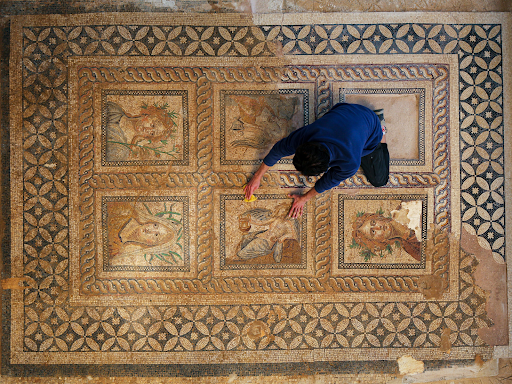
The ancient city of Metropolis continues to yield works of beauty and wonder. An excavation site since 1990, the digs are supported by the Sabancı Foundation, with considerable assistance from Turkey’s Ministry of Culture and Tourism. This year, the restoration of mosaic art portraits of the Greek gods Ariadne, Eros, and Dionysius has made headlines.
What makes the finds at Metropolis so special? Let’s run down a bit of the history and lore of this former center of culture and commerce. First of all, its history runs quite deep – archaeologists have recovered traces of Late Neolithic settlements. It remained a powerhouse all the way to the Classical Age, from the Hellenistic Age to the Roman and Byzantine periods, and on to Anatolian beyliks (principalities) and the Ottoman era. The civilizations who have called the area home are diverse, and the fertile, strategic location has meant that it was continuously occupied.

It’s no wonder that the Izmir Archaeological Museum in western Turkey, which receives and displays the finds, is a top destination. The payoff for these ongoing excavations has been major: more than 11,000 historical artifacts, including ceramics, coins, glass, architectural pieces, figures, sculptures, bone and ivory artifacts along with various metal items.
Left in place: Structures, ancient cistern systems, and a multitude of mosaic art – including the Greek pantheon that’s under painstaking restoration. It’s located in what’s believed to be a former guest house that’s connected to the Hellenistic theater.
As Dionysius was the god of entertainment and theater, and specially tasked with protecting performers and performances. it’s only fitting that he would be featured in a building that hosted special guests of the adjacent theater.
However, the patron of wine and merriment is not alone in the Metropolis restoration. He’s also accompanied by his wife, Ariadne, as well as Eros, the God of Love. Officials involved with the work have commented upon the look of tenderness shown on the faces of the married couple. Indeed, the artistry of the marble mosaic art is superb, with subtle shadings and fine details.

Restoration of the large floor area has involved the latest, most state-of-the-art techniques. The process has enhanced and restored the original stone colors, bringing them back to the way they looked 1800 years ago, perhaps.
Also depicted in the mosaic art floor installation: additional symbols associated with the theater. Look closely, and you’ll discover masks used in performances. Other figures are those of native fish and birds.

Their survival after more than 18 centuries is a true testimony to the durability of mosaic art installations!
Even coated with layers of lime accumulated since ancient times, the uncleaned mosaic art was still striking, with unmistakable subjects.

Elsewhere in the city, the Roman bathhouse, Palaestra Complex, Stoa, and cistern system are also under restoration and excavation. The sprawling city was organized and carefully planned, with many traditional Roman structures present. A study of the extensive cistern system continues this year. In previous seasons, archaeologists unearthed and identified a parliamentary building (Bouleuterion), a palaestra (sports complex), multiple bathhouses, and an entire hall of mosaics. Expect to hear more news on mosaic art discoveries as their work continues.

Be sure to keep up with the latest mosaic art news, interior style ideas, and much more by subscribing to our newsletter!

